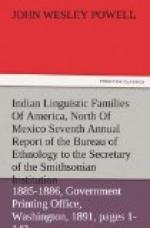The main territory of the Kulanapan family is bounded on the west by the Pacific Ocean, on the east by the Yukian and Copehan territories, on the north by the watershed of the Russian River, and on the south by a line drawn from Bodega Head to the southwest corner of the Yukian territory, near Santa Rosa, Sonoma County, California. Several tribes of this family, viz, the Kastel Pomo, Kai Pomo, and Kato Pomo, are located in the valley between the South Fork of Eel River and the main river, and on the headwaters of the South Fork, extending thence in a narrow strip to the ocean. In this situation they were entirely cut off from the main body by the intrusive Yuki tribes, and pressed upon from the north by the warlike Wailakki, who are said to have imposed their language and many of their customs upon them and as well doubtless to have extensively intermarried with them.
TRIBES.
Ballo Kai Pomo, “Oat Valley People.”
Batemdikayi.
Buldam Pomo (Rio Grande or Big River).
Chawishek.
Choam Chadila Pomo (Capello).
Chwachamaju.
Dapishul Pomo (Redwood Canon).
Eastern People (Clear Lake about Lakeport).
Erio (mouth of Russian River).
Erussi (Fort Ross).
Gallinomero (Russian River Valley below
Cloverdale
and in Dry Creek Valley).
Grualala (northwest corner of Sonoma County).
Kabinapek (western part of Clear Lake
basin).
Kaime (above Healdsburgh).
Kai Pomo (between Eel River and South
Fork).
Kastel Pomo (between Eel River and South
Fork).
Kato Pomo, “Lake People.”
Komacho (Anderson and Rancheria Valleys).
Kula Kai Pomo (Sherwood Valley).
Kulanapo.
Lama (Russian River Valley).
Misalamag[-u]n or Musakak[-u]n (above
Healdsburgh).
Mitoam Kai Pomo, “Wooded Valley
People” (Little Lake).
Poam Pomo.
Senel (Russian River Valley).
Shodo Kai Pomo (Coyote Valley).
Siako (Russian River Valley).
Sokoa (Russian River Valley).
Yokaya Pomo, “Lower Valley People”
(Ukiah City).
Yusal (or Kamalel) Pomo, “Ocean
People”
(on coast and along Yusal
Creek).
KUSAN FAMILY.
= Kusa, Gatschet in Mag. Am. Hist., 257, 1883.
Derivation: Milhau, in a manuscript letter to Gibbs (Bureau of Ethnology), states that “Coos in the Rogue River dialect is said to mean lake, lagoon or inland bay.”
The “Kaus or Kwokwoos” tribe is merely mentioned by Hale as living on a river of the same name between the Umqua and the Clamet.[65] Lewis and Clarke[66] also mention them in the same location as the Cookkoo-oose. The tribe was referred to also under the name Kaus by Latham,[67] who did not attempt its classification, having in fact no material for the purpose.
[Footnote 65: U.S. Expl. Exp., 1846, vol. 6, p, 221.]
[Footnote 66: Allen Ed., 1814, vol. 2, p. 118.]




